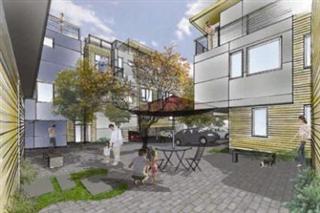
SEATTLE, WA - After Mayor Greg Nickels proposed new regulations for townhouses, some believe the process could become even more prolonged and costly. But a group of architects now hopes to share the importance of multi-family housing and its new flexible zoning. The city design review process hopes to encourage more tasteful townhomes that will blend in rather than stick out like sore thumbs in mixed housing communities. The city hopes the new regulations will create more open space, wider driveways and larger parking spots, and cause entrances to face the street and more windows and doors to fill up blank walls.
In support of the proposed new regulations the Congress of Residential Architecture Northwest of Seattle, a nationally accredited group, has been going into the smaller communities to ease the stigma residents have of the many townhomes taking over their neighborhood. Instead the group is shedding new light on the endless possibilities of townhome designs that will blend into Ballard's single-family neighborhoods.
"We're a grassroots group of architects who are all practitioners of single-family or multi-family homes," said David Neiman of Neiman Architects. "Currently the townhome code was designed in the 1980s with the vision of how multi-family housing should appear like single-family housing, mandating roof forms and yard entrances to be like single-family housing."
The problem of residents parking cars on the street forced parking structures to be incorporated into the structure design. Neiman said parking for single-family housing was easy to accommodate because one piece of property usually had one car to house while townhomes have multiple buildings and multiple cars on one piece of property, creating a major parking problem.
This problem ended up with "four-pack" townhome developments, with two units in the front and two units in the back and a parking aisle that goes in between. Thus the design that became a standard design in Seattle. "This is not a housing typology or design it's a parking design," said Neiman. "For 20 years we've been forced to build buildings in a certain way that no one intended, so we have been trapped in this highly prescriptive code."
Neiman says with the new design proposal the city is recognizing this problem. "By redesigning the code to be more flexible, the Seattle Department of Planning and Development will allow architects and developers the freedom to test a variety of housing archetypes and let the marketplace of ideas find better housing solutions that are appropriate for our neighborhoods," said Neiman.
With the flexibility in the proposed code, there will be alternate ways to design townhomes and to solve the current parking dilemma of covered central parking courts or underground parking. The new design will see vehicles brought in the center of the site instead of underneath the buildings. By keeping the cars in the center, the townhomes are spread farther apart giving more room for the cars parked in the middle. The center parking will then be covered with a green roof or something that provides open space for people's homes.
"Because you're giving up this area for cars you can build the same size townhome with one less story," said Neiman. "In a typical townhome the entire ground plane is given to the cars so your living space is totally disconnected from the outdoors and your open space. In this new design you have a meaningful lower story that is used for human occupation and not cars."
He said an idea that east coast developers have been using for years is placing parking completely underground. Buildings will be close to the street, porches and stoops will provide a staging ground for activities and open spaces will be provided through a mixture of interior court and roof top terraces. Another idea for underground parking is to build a pedestrian courtyard. Townhomes will be built as close as possible to the street to open up a large common space in the center of the property. Parking would either be in a peripheral location or underneath the courtyard.
However, with new design ideas and the additional mandatory review some developers are concerned with the amount of time and money that could be added to their projects. On average developers wait eight months to one year for a design to be reviewed and approved, Miklos Kohary of Kohary Construction said. If the new review follows this time pattern it will become more costly and inefficient for both builders and buyers.
What is different about the new proposed mandatory design review is, unlike the current optional community design review where the design is under public process, the review will become an administrative city design review where one staff member of the department of planning and development will look over and process all designs.
"It will take a little more time and will cost designers for that time but what makes it okay is that everybody has to do it so no one will have an advantage over another person," Neiman said. "It's a universal increase in time and cost. Everyone will now have to play by the same rules and no one is disadvantaged by it." The proposal will be going to Council member Sally Clark's committee for review this fall.
Source: WestSeattleHerald.com